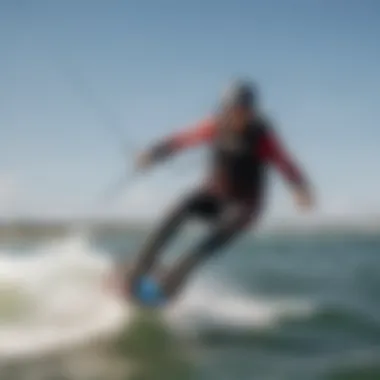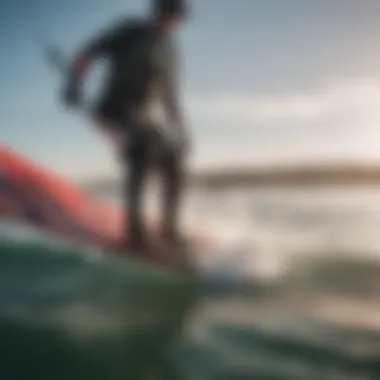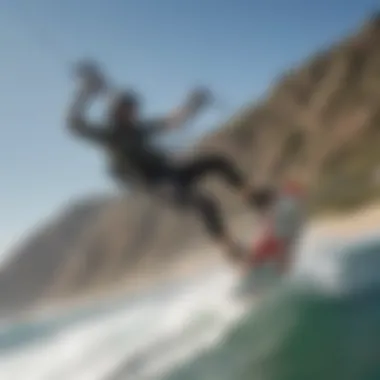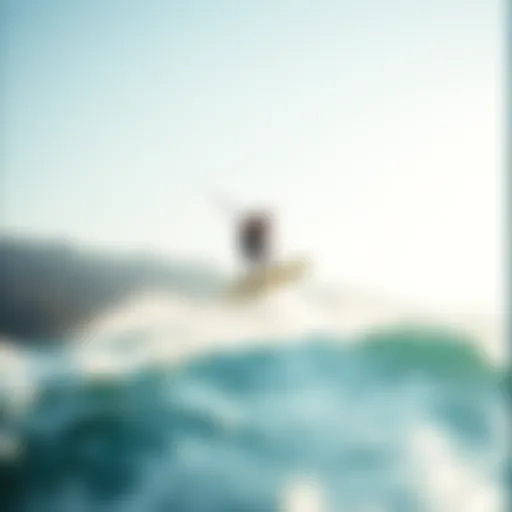Mastering the Strike Ride in Kiteboarding Techniques


Intro
Kiteboarding is an exhilarating sport that merges the thrill of surfing with the finesse of flying a kite. Among the various techniques that riders learn, the strike ride stands out due to its demand for precision and skill. This maneuver encapsulates the essence of kiteboarding: balancing power, control, and technique. Riders looking to master the strike ride must navigate a path filled with unique challenges and insights that can ultimately elevate their performance. Understanding the intricacies involved in this maneuver is essential for anyone serious about advancing their kiteboarding prowess.
In this exploration of the strike ride, we will delve into the underlying mechanics, different approaches to mastering it, and key elements crucial for enhancement. Alongside the practical know-how, we will tackle the inevitable hurdles that come with the learning process, including a focus on choosing the right equipment and ensuring rider safety. By bridging the gap between theory and execution, this guide aims to provide kiteboarding enthusiasts with the knowledge required to refine their skills and enjoy the journey as much as the destination.
Foreword to the Concept of Strike Ride
Kiteboarding is not just about riding the waves; it's an intricate dance of skill, balance, and technique that culminates in impressive maneuvers. One of the most acclaimed techniques in this sport is the strike ride, a maneuver that showcases a rider's ability to harness both wind and kite dynamics. Understanding the strike ride is crucial, not merely for its aesthetic appeal, but for the very foundation it lays in a kiteboarder's journey. This section aims to shed light on the significance of the strike ride, the cognitive aspects surrounding it, and the advantages it brings to practitioners.
Why the Strike Ride Matters
The strike ride is often regarded as a gateway to more advanced moves. Riders who master this technique are likely to build confidence and develop a deeper understanding of kite control. When a boarder can finesse their strike ride, they inherently gain a better handle on wind conditions, kite responsiveness, and body positioning.
- Skill Development: Executing a strike ride effectively requires a blend of refined skills, making it a building block for more complex maneuvers.
- Safety: Understanding the dynamics involved in the strike ride can enhance a rider's safety awareness. Recognizing how to adjust posture or balance when under strain leads to fewer accidents.
- Community Engagement: As more kiteboarders embrace the strike ride, there’s a natural increase in community interactions. Learning and sharing tips can enhance the culture of kiteboarding, renewing the passion among enthusiasts.
In essence, the strike ride is more than just a trick; it embodies the unity of technical prowess and creative expression in kiteboarding. As we venture deeper into this discussion, we aim to explore the specifics of what the strike ride entails, and how it reflects the evolution of kiteboarding as a whole.
Defining the Strike Ride
At its core, the strike ride is a dynamic maneuver that involves a rider transitioning smoothly from one trajectory to another while maintaining control of the kite. It's a playful mix of speed, finesse, and spatial awareness; essentially, it's about striking that fine balance between power and precision.
A common definition situates the strike ride as an act where the rider utilizes the kite's pull to propel themselves across the water, often incorporating a slight jump or a change of elevation. The maneuvers can vary based on wind speed and rider skill, leading to different styles of execution. In simple words, a successful strike ride should feel like a fluid movement where the rider embraces the forces acting upon them.
Key Components of the Strike Ride
- Kite Control: The kite must be managed in a way that it draws power without overloading the rider.
- Body Coordination: A precise synchronization between upper and lower body is needed to steer and balance effectively.
- Timing: Knowing when to catch a gust of wind is crucial for a successful strike.
Historical Context of Kiteboarding Maneuvers
Kiteboarding, though a relatively young sport compared to surfing or windsurfing, has seen rapid evolution since its inception in the late 20th century. Understanding the historical context of its maneuvers provides insight into how techniques like the strike ride have developed.
The roots of kiteboarding trace back to the 1960s, when adventurous spirits began experimenting with kites for propulsion. However, it wasn’t until the late 1990s that the sport gained traction, leading to the birth of various maneuvers. Initially, riders relied on larger kites and straightforward techniques. Over the years, as technology and training methods advanced, so did the complexity of maneuvers, including the strike ride.
The strike ride emerged as riders began to discover the capabilities of smaller, more modern kites, allowing for increased mobility. Today, the strike ride represents a hallmark of progression within kiteboarding, symbolizing how far the sport has come.
- Evolution of Equipment: Advances in kite materials and board design have played a substantial role in facilitating maneuvers like the strike ride.
- Culture of Innovation: As riders pushed boundaries, they began sharing knowledge across forums and competitions, fostering a spirit of innovation.
- Influence of Community: Enthusiastic communities, both online and offline, have fueled the evolution of tricks in kiteboarding, contributing to the rich tapestry of maneuvers available today.
In a nutshell, understanding the historical context of kiteboarding maneuvers paves the way for comprehending the influence of the strike ride within the realm of this thrilling sport.
The Mechanics of the Strike Ride
Understanding the mechanics of the strike ride is crucial for anyone looking to improve their kiteboarding skills. This maneuver requires a delicate balance of body positioning, kite handling, and wind dynamics. By developing a solid grasp on these elements, riders can maximize their performance, elevate their enjoyment, and ultimately have more fun on the water.
Understanding the Kite's Role
The kite is not just a tool; rather, it’s the engine that powers the whole operation. Its position in the sky determines the amount of lift and the type of pull a rider experiences. During a strike ride, understanding how to manipulate the kite's positioning can make or break the move. If the kite is too low, it can pull you down like a ton of bricks, while positioning it higher can give you the needed lift.
Key points to consider include:
- Angle of Attack: The angle at which the kite meets the wind influences the amount of lift generated. Finding the sweet spot can result in a smoother ride.
- Power Zone: This is the area where the kite catches the most wind. Keeping your kite within this zone during the maneuver is vital for maintaining speed and control.
- Steering: Quick and precise adjustments are necessary. Pulling hard on one side of the control bar gives more power, while the other side can help in radical turns. This dual control can keep the kite responding to your body’s movements.
Body Position and Movement
Your body acts as the link between the kite and the board. Proper positioning can create synergy that enhances both speed and stability. When you’re preparing for a strike ride, your stance should be solid yet flexible.


- Feet Position: Keep your feet shoulder-width apart. This stance helps in absorbing shocks and maintaining balance.
- Knees Bent: Bending your knees can help in adjusting to changing wind dynamics. A low center of gravity aids in better control when navigating through various wind conditions.
- Weight Distribution: Leaning forwards can generate speed, while leaning back offers better stability. Knowing when to shift your weight is an essential skill.
Having an awareness of your body’s position in relation to the kite makes movement fluid and allows for better response to the kite's pull.
Wind Dynamics and Its Impact
Wind conditions play a pivotal role in kiteboarding, especially during the strike ride. Failing to consider the wind can lead to erratic movements or loss of control. Understanding wind dynamics involves recognizing both speed and direction.
- Wind Speed: Mild winds offer a different ride than strong, gusty patterns. Gauge wind strength before composing your strike ride to set realistic expectations.
- Consistent Direction: Wind can shift unexpectedly, changing how your kite interacts in the air. Anticipating these changes will help you ride better.
- Local Wind Patterns: Each riding location can present its own wind quirks. Studying local conditions will set you up for success.
"Kiteboarding isn't just a sport; it’s a dance with the elements, where every maneuver tells your story."
Embracing these mechanics will not only enhance your skills but also enrich your overall kiteboarding experience.
Mastering the Strike Ride Technique
Mastering the strike ride technique is a cornerstone for anyone looking to refine their skills in kiteboarding. Based on precision, timing, and body movements, this maneuver has a significant impact on overall performance and style. There's more to kiteboarding than just catching waves or gliding on the water; it's about expressing oneself through each turn, jump, and ride. The strike ride is particularly beloved because, when executed correctly, it showcases dexterity and control, both vital attributes for bold kiteboarders.
Understanding the mechanics behind this technique can contribute to a deeper appreciation of the sport. As with any skill, the path to mastery involves a willingness to adapt, learn, and overcome challenges. Riders who take the time to hone their strike ride technique can elevate their escapades, boost their confidence, and enhance their enjoyment of the sport.
The internal and external benefits are worthy of consideration as well. Not only does mastering the strike ride lead to impressive maneuvers, but it also builds a solid foundation for tackling more advanced techniques down the line. Knowing the nuances of this maneuver provides riders with an edge, propelling them farther in their kiteboarding journey.
Step-by-Step Approach for Beginners
Beginning the journey toward mastering the strike ride can seem daunting. However, breaking it down into manageable steps often makes this endeavor more approachable. Here’s how to start:
- Understand the Basics: Familiarize yourself with kite control, as the kite’s positioning is paramount in initiating the strike ride. Knowing how to steer and position your kite will significantly impact your balance throughout the ride.
- Posture and Balance: Stand with your knees slightly bent and feet shoulder-width apart. Proper stance helps maintain stability while allowing for agile movements. Lean slightly forward to prepare for the water's surface impact.
- Timing Your Movement: As the kite reaches its zenith, it’s time to maneuver. Tuck your knees, pull your board to the side, and lean into the direction of the ride. Coordinate your weight with the kite’s pull to stabilize your landing.
- Practice, Practice, Practice: Repeat the maneuver in different wind conditions. Familiarity breeds confidence, which is crucial for executing more refined techniques as you progress.
Advanced Techniques for Experienced Riders
With a solid foundation behind you, it's time to level up your skills. Experienced riders can expand on the strike ride technique to incorporate more advanced maneuvers, which not only look cool but also provide a greater thrill. Here are some strategies:
- Incorporate Jumps: Adding jumps into the mix can elevate your strike ride. Work on timing your weight shifts so your board leaves the water as your kite reaches the zenith. The height and grace of your jump will depend heavily on this delicate coordination.
- Try Grabs and Spins: As you become more comfortable, consider adding grabs to your jumps or incorporating spins mid-air. These elements can significantly enhance the visual appeal of your maneuvers and set you apart from other riders.
- Experiment with Speed: Varying the speed of your ride can change the dynamics of the maneuver. Learning to adapt your strike ride technique to different speeds adds versatility to your style.
By embracing these advanced elements, riders express creativity and finesse, transforming a simple strike ride into a full-blown spectacle.
Common Mistakes and How to Avoid Them
Even seasoned riders can fall prey to common pitfalls during the strike ride. Awareness of these mistakes allows for quick rectification and better performance. Examples include:
- Over-Reliance on Kite Power: Some riders depend heavily on their kite, which can lead to loss of balance. Instead, focus on distributing your weight evenly over your board.
- Inadequate Body Position: Failing to maintain proper body posture can throw off your entire maneuver. Remember to keep your center of gravity low and knees bent.
- Ignoring Wind Conditions: Every wind condition requires an adjustment in your technique. Being aware of how wind interacts with your kite can give you a significant advantage and prevent mishaps.
To wrap it up, continually assess your performance. Being introspective enables growth and pushes the envelope of what can be achieved on the water. The strike ride is a tremendous expression of skill, and with the right guidance, it can be the crown jewel of your kiteboarding repertoire.
Essential Equipment for the Strike Ride
When it comes to kiteboarding, having the right equipment is crucial, particularly when trying to master the strike ride. The strike ride is a nuanced maneuver that demands precision, control, and an understanding of your gear. Choosing the right equipment can not only enhance your performance but also ensure safety while riding.
Choosing the Right Kite
The kite is arguably the heart and soul of kiteboarding. Selecting the right one is fundamental for executing the strike ride effectively. You should consider size, type, and condition when making your choice.
- Size Matters: The size of the kite influences the amount of power it generates. A bigger kite offers more lift but can also be harder to manage, especially in strong winds. Conversely, a smaller kite provides more agility but might not deliver enough force in lighter winds.
- Type of Kite: Different types of kites suit different styles of riding. For the strike ride, many riders prefer a C-kite for its explosive pop, which helps in achieving the necessary height for tricks. However, some might opt for a hybrid kite for its versatility.
- Condition: Always inspect the kite for wear and tear. A frayed leading edge or damaged bladders can compromise safety and performance.


Board Selection Criteria
The board complements the kite by providing the rider with stability and maneuverability. Choosing the right board is a critical factor for mastering the strike ride.
- Shape: Boards come in various shapes, and the one you choose can significantly affect your performance. A wider board can offer enhanced buoyancy and stability, while a narrower one might allow swift turns and tricks.
- Material: Look for high-quality materials such as fiberglass or carbon fiber for lightweight and durability. A robust board will withstand the rigors of riding, especially if you’re frequently hitting the water or landing tricks.
- Length: The length of the board can impact your riding style as well. Shorter boards offer quicker responses and are generally better for freestyle maneuvers, while longer boards provide more speed and tracking.
Harness Specifications
The harness holds everything together, so it’s not something to overlook. Whether you go for a seat harness or a waist harness largely depends on personal preference, but both need to be chosen with care.
- Fit and Comfort: Your harness should fit snugly without digging into your body. A good fit prevents chafing and allows you to ride longer without discomfort. Look for adjustable options that can be customized to your body shape.
- Support and Mobility: A harness needs to provide support without restricting movement. Feature-rich harnesses often come with additional padding and support mechanisms, which can enhance comfort.
- Leash Attachment: Ensure that the harness has a reliable attachment point for the leash. This can serve as a lifesaver in case you lose your kite, helping to maintain control of your gear.
Remember: The right equipment not only enhances your performance in the strike ride but also plays a vital role in ensuring safety during your kiteboarding experience. Invest time in understanding what works best for you.
Equip yourself properly and you’ll find that the strike ride not only becomes easier but also a much more enjoyable experience.
Safety Considerations in Kiteboarding
Kiteboarding is certainly an exhilarating sport, but it can also pose its share of hazards, making safety measures crucial for everyone involved. Understanding the risks and taking necessary precautions not only prevents accidents but also encourages a positive riding experience. This section will enlighten enthusiasts about the principal safety elements to keep in mind when kiteboarding, with an emphasis on assessing wind conditions and wearing protective gear.
Assessing Wind Conditions
One of the foremost considerations for any kiteboarder is the wind. The kite's performance and rider's stability are profoundly influenced by the wind's speed and direction. Understanding these elements can be the difference between an adrenaline-pumping session and a dangerous mishap.
Key Aspects to Consider:
- Wind Speed: Before hitting the waves, it’s essential to check the wind speed. Wind that’s too light won't propel the kite or the rider adequately, while overly strong winds can lead to loss of control. A good rule of thumb is for beginners to stick to a range of 12 to 20 knots.
- Wind Direction: Ideal riding conditions hinge on consistent wind direction, preferably onshore or side-onshore winds. Offshore winds may seem appealing, but they can quickly lead to serious trouble, carrying riders away from the shore and complicating recovery.
- Wind Gusts: Sudden changes in wind strength can turn a calm day into chaos. Gusty winds cause unpredictable kite behavior that challenges even experienced riders. It's wise to remain vigilant to not only the average wind speed but also the gusts.
Ultimately, diligent assessment of wind conditions speaks volumes in ensuring safety on the water. If conditions aren't suitable, it's best to wait or choose another day.
Importance of Wearing Protective Gear
The robustness of kiteboarding equipment can only go so far in preventing injury. The rider's safety gear is an invaluable line of defense, safeguarding against potential accidents ranging from minor scrapes to severe impacts. Wearing the appropriate protective gear should never be considered optional; instead, it is fundamental.
Essential Protective Gear:
- Helmets: A good helmet shields the head in case of falls or unexpected kite encounters. Choose a model that fits snugly and is buoyant enough to float.
- Impact Vests: These provide both buoyancy and cushioning, reducing the risk of injury from hard landings. Some vests come equipped with flotation features that help in keeping the rider afloat while increasing safety against impacts.
- Wetsuits: Not only do wetsuits offer thermal protection, but they also cushion against accidental bumps or falls. Opting for a wetsuit that fits well is crucial for maneuverability.
- Harnesses: A proper harness allows for better control and reduces strain on the body. Ensuring that the harness fits correctly can greatly boost comfort and reduce the chance of injury.
“Safety first is safety always.”
In kiteboarding, prioritizing protective equipment can effectively reduce injury rates and increase the joy of riding. When riders arm themselves with the right gear and knowledge, the focus shifts from worry to actual riding—enhancing not only personal safety but also the overall kiteboarding experience.
Remember, by integrating savvy wind assessments and essential protective gear into your kiteboarding practice, you'll not only protect yourself but potentially enjoy longer, more fulfilling sessions on the water.
Evaluating Performance in the Strike Ride
Evaluating performance in the strike ride isn’t just a checkmark on a to-do list; it’s an essential aspect that shapes how a kiteboarder grows and excels at this pivotal maneuver. This evaluation helps in gaining insights into one's strengths and weaknesses while also opening doors to continuous improvement. Through active engagement in performance analysis, kiteboarders can refine their technique, boost their confidence, and even maximize their enjoyment of the sport.
One vital element of evaluating performance is understanding the criteria of success for the strike ride. How high does the rider jump? Is the landing smooth and controlled? Are the movements executed with fluidity? These elements are not merely arbitrary; they pave the way for setting benchmarks in personal skill development. A keen eye for these details can help foster a constructive learning environment, whether that be through individual reflection or feedback from peers.
Moreover, evaluating performance gives an opportunity to recognize and celebrate achievements. Every personal best—be it a higher jump or a trick landed more gracefully—deserves recognition. Celebrating these milestones fuels motivation and drives riders to strive for higher goals.
Setting Personal Goals


Setting personal goals is perhaps the most effective way to chart a path forward in mastering the strike ride. Goals serve as compass points that guide a rider's practice sessions, helping them stay focused and motivated.
When creating goals, it’s beneficial to adhere to the SMART criteria—Specific, Measurable, Achievable, Relevant, and Time-bound. For example, rather than vaguely stating, "I want to get better at the strike ride," a better goal might be, "I aim to increase my jump height by two feet within a month." This clarity in goal-setting acts like a roadmap, making it easier to identify the steps necessary to achieve success.
Consider how riding in different conditions could impact these goals. Wind speed and water surface can greatly affect how one executes a strike ride. Adjusting goals based on these factors cultivates adaptability, a trait crucial for any kiteboarder.
Utilizing Video Analysis
In today's digital age, video analysis is a powerful tool that can significantly aid in performance evaluation. Watching oneself in action can reveal overlooked aspects of technique. For instance, a kiteboarder may feel they're rotating perfectly, but on video, their body position might reveal a breakdown in form that's invisible in real-time.
One approach to video analysis involves recording sessions from multiple angles. This gives a holistic view of the performance, allowing the rider to analyze different elements of the strike ride. Are the arms too rigid? Is the kite held incorrectly during the landing? These are nuances that video can make clear.
Here are some pointers for effective video analysis:
- Use slow motion: It’s easier to spot errors when movements are slowed down.
- Compare with professional riders: Watching experts perform the strike ride can provide benchmarks for improvement.
- Take notes: Jot down observed areas for improvement so you can focus on them in practice.
By incorporating both personal goals and video analysis into the evaluation process, kiteboarders can create a comprehensive framework for enhancing their strike ride technique. This method not only builds competence but also lays the groundwork for greater enjoyment of the sport, as improvement often brings a deeper connection to the activity and satisfaction with one’s progress.
The Community Aspect of Kiteboarding
Kiteboarding is not just a sport; it’s a community of enthusiasts who share a common passion, a kind of brotherhood and sisterhood that exists on the waves and the beaches. Engaging with fellow kiteboarders significantly enhances the experience, providing support, camaraderie, and a wealth of shared knowledge. This collective engagement fuels personal development and cultivates a thriving environment where both beginner and seasoned riders can connect, learn, and inspire one another.
Finding Local Riding Groups
Joining a local riding group can be a game-changer for any kiteboarder. These groups often serve as a lifeline, offering guidance and fostering friendships that nourish the spirit of the sport. Here are some advantages of becoming a member of such communities:
- Learn Together: Riding with others provides a fantastic opportunity to learn new techniques, share tips, and receive real-time feedback.
- Safety in Numbers: It’s always safer to ride with others, especially when you’re trying out new moves. Group rides can help ensure that assistance is readily available when needed.
- Access to Local Knowledge: Experienced locals often know the best spots, conditions, and potential hazards, which can save newcomers from a lot of trouble.
- Social Events: Many groups organize events that create social interactions beyond kiteboarding. These gatherings can deepen connections and create lasting friendships.
To find a local riding group, a good start is social media platforms such as Facebook, where communities often form around specific regions. Websites such as reddit.com may also contain threads that help connect you with other enthusiasts in your area.
"The best part of kiteboarding is not just carving through the waves, but sharing the ride with a community of passionate individuals."
Participating in Competitions
Competitions can seem daunting at first glance, but they serve as excellent platforms for personal growth and skill enhancement. Engaging in competitions encourages kiteboarders to push their limits and refine their techniques under pressure. Here are some reasons to consider competition:
- Skill Development: Competing forces you to elevate your game, practice diligently, and focus on mastering your craft.
- Setting Goals: Preparation for competitions can help you set tangible goals, whether it is perfecting specific maneuvers or improving overall consistency.
- Networking Opportunities: Competing can introduce your skills to a broader audience, potentially opening doors to sponsorships, collaborations, or friendships with other passionate riders.
- Experience Under Pressure: The thrill of competition introduces a unique adrenaline rush that can hone your instinctual reactions and problem-solving abilities in challenging situations.
While venturing into competitions, remember that the journey should be about self-improvement rather than just winning. Embrace the thrill of competition as an opportunity to learn from others, celebrate achievements, and enjoy the sport.
In sum, kiteboarding is enriched by its community. Connecting with local riding groups and competing can foster a deeper understanding of the sport and enhance both enjoyment and skill development. As you navigate your kiteboarding journey, seek out these communities and remember that every ride is better shared.
Future Trends in Kiteboarding Techniques
The kiteboarding landscape is ever-evolving. As technology advances, so do the techniques and styles of riding. Keeping an eye on future trends is essential for riders who want to stay at the top of their game, whether they are beginners or seasoned pros. Not only do these emerging elements enhance the overall riding experience, they also offer innovative ways to push the boundaries of this thrilling sport. Understanding these trends can lead to better performance, increased safety, and a deeper appreciation for the craft.
Emerging Technologies in Equipment
In the world of kiteboarding, the equipment has always been a pillar of success. Recent advancements in materials and design have introduced lighter, more durable kites and boards that adapt to a variety of conditions.
- Material Innovations: The introduction of lightweight composites and advanced fabrics has improved the performance and longevity of gear. Riders now benefit from kites that react quicker and provide greater lift with less wind.
- Smart Technology: Some brands are rolling out kites fitted with sensors. These devices provide real-time data about wind speed, kite angle, and altitude. It’s as if riders now have an assistant right there with them, helping to make quick adjustments in the air that can turn a good ride into a great one.
- Sustainable Practices: There’s also a growing trend towards eco-friendly products. Companies are focusing on using sustainable materials and practices, allowing environmentally conscious riders to enjoy their sport without the guilt.
"Staying ahead in kiteboarding isn't just about skills; it's also about embracing the future of technology."
Evolution of Riding Styles
Kiteboarding has always been influenced by various styles, and that evolution is crucial for the sport's growth. As riders experiment and innovate, new styles emerge, pushing the boundaries of what's possible on the water.
- Freestyle Vibes: The freestyle discipline has been gaining momentum. Riders are focusing on complex tricks, flips, and spins, leading to an increase in competitions globally. This has inspired many to focus their training specifically on perfecting their freestyle skills.
- Wave Riding: There’s a renewed interest in wave riding. With the emergence of specialized gear designed for surfing waves, riders are now combining kiteboarding with traditional surf techniques, creating a unique fusion that’s both challenging and exhilarating.
- Lightwind Riding: As awareness of varying wind conditions grows, many riders are embracing lightwind kiteboarding. This allows them to ride in conditions that were previously deemed unsuitable, encouraging creativity and adaptation.
The continuous shift in styles reflects the diverse interests in the kiteboarding community, encouraging riders to develop their unique flair while respecting the deep-rooted traditions of the sport.







